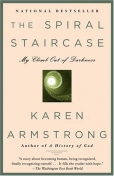BKMT READING GUIDES
The Spiral Staircase: My Climb Out of Darkness
by Karen Armstrong
Paperback : 305 pages
2 clubs reading this now
1 member has read this book
Introduction
Gripping, revelatory, and inspirational, The Spiral Staircase is an extraordinary account of an astonishing spiritual journey. In 1962, at age seventeen, Karen Armstrong entered a convent, eager to meet God. After seven brutally unhappy years as a nun, she left her order to pursue English literature at Oxford. But convent life had profoundly altered her, and coping with the outside world and her expiring faith proved to be excruciating. Her deep solitude and a terrifying illness–diagnosed only years later as epilepsy—marked her forever as an outsider. In her own mind she was a complete failure: as a nun, as an academic, and as a normal woman capable of intimacy. Her future seemed very much in question until she stumbled into comparative theology. What she found, in learning, thinking, and writing about other religions, was the ecstasy and transcendence she had never felt as a nun.
Editorial Review
Karen Armstrong speaks to the troubling years following her decision to leave the life of a Roman Catholic nun and join the secular world in 1969. What makes this memoir especially fascinating is that Armstrong already wrote about this era once---only it was a disastrous book. It was too soon for her to understand how these dark, struggling years influenced her spiritual development, and she was too immature to protect herself from being be bullied by the publishing world. As a result, she agreed to portray herself only in as "positive and lively a light as possible"---a mandate that gave her permission to deny the truth of her pain and falsify her inner experience. The inspiration for this new approach comes from T. S. Eliot's Ash Wednesday, a series of six poems that speak to the process of spiritual recovery. Eliot metaphorically climbs a spiral staircase in these poems---turning again and again to what he does not want to see as he slowly makes progress toward the light. In revisiting her spiral climb out of her dark night of the soul, Armstrong gives readers a stunningly poignant account about the nature of spiritual growth. Upon leaving the convent, Armstrong grapples with the grief of her abandoned path and the uncertainty of her place in the world. On top of this angst, Armstrong spent years suffering from undiagnosed temporal lobe epilepsy, causing her to have frequent blackout lapses in memory and disturbing hallucinations---crippling symptoms that her psychiatrist adamantly attributed to Armstrong's denial of her femininity and sexuality. The details of this narrative may be specific to Armstrong's life, but the meanin! g she makes of her spiral ascent makes this a universally relevant story. All readers can glean inspiration from her insights into the nature of surrender and the possibilities of finding solace in the absence of hope. Armstrong shows us why spiritual wisdom is often a seasoned gift---no matter how much we strive for understanding, we can't force profound insights to occur simply because our publisher is waiting for them. With her elegant, humble and brave voice, she inspires readers to willingly turn our attention toward our false identities and vigilantly defended beliefs in order to better see the truth and vulnerability of our existence. Herein lies the staircase we can climb to enlightenment. --Gail HudsonDiscussion Questions
No discussion questions at this time.Book Club Recommendations
Recommended to book clubs by 0 of 0 members.
Book Club HQ to over 90,000+ book clubs and ready to welcome yours.
Get free weekly updates on top club picks, book giveaways, author events and more








